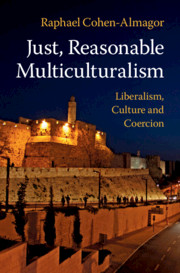Book contents
- Just, Reasonable Multiculturalism
- Just, Reasonable Multiculturalism
- Copyright page
- Dedication
- Contents
- Figures
- Acknowledgements
- Theory of Just, Reasonable Multiculturalism
- Introduction
- Part I Theory
- 1 Just Liberal Democracy
- 2 Reasonable Multiculturalism
- 3 Compromise and Deliberative Democracy
- 4 Coercion
- Part II Interference in Minority Affairs: Physical Harm
- Part III Interference in Minority Affairs: Non-physical Harm
- Part IV Country Case Studies
- Conclusion
- Select Bibliography
- Index
1 - Just Liberal Democracy
from Part I - Theory
Published online by Cambridge University Press: 19 July 2021
- Just, Reasonable Multiculturalism
- Just, Reasonable Multiculturalism
- Copyright page
- Dedication
- Contents
- Figures
- Acknowledgements
- Theory of Just, Reasonable Multiculturalism
- Introduction
- Part I Theory
- 1 Just Liberal Democracy
- 2 Reasonable Multiculturalism
- 3 Compromise and Deliberative Democracy
- 4 Coercion
- Part II Interference in Minority Affairs: Physical Harm
- Part III Interference in Minority Affairs: Non-physical Harm
- Part IV Country Case Studies
- Conclusion
- Select Bibliography
- Index
Summary
The opening chapter revolves around the questions: What does liberalism purport to include within the defence of neutrality? What scope is available for conceptions of the good to meet, to mingle and to rival each other? In order to answer these questions, we need to understand what liberal democracy is about, what its ground rules are and how we can distinguish liberal democracies from illiberal societies. To address these important questions, the chapter avails itself of the Rawlsian justice as fairness theory which greatly influenced the liberal discourse during the past century. The Rawlsian theory of justice is supplemented with Kantian and Millian ethics. The chapter elucidates two important concepts without which it is impossible to imagine any liberal democracy: respect for others, inspired by Kantian and Rawlsian philosophies, and the Harm Principle derived from J. S. Mill’s ethics. It is the Harm Principle that guides us in prescribing boundaries to conduct. The necessity in introducing boundaries is further explained by the concept of the ‘democratic catch’.
- Type
- Chapter
- Information
- Just, Reasonable MulticulturalismLiberalism, Culture and Coercion, pp. 23 - 44Publisher: Cambridge University PressPrint publication year: 2021



